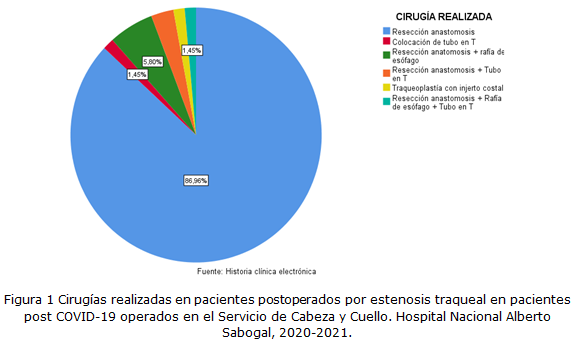Traqueostomía tardía y estenosis traqueal en pacientes post COVID-19 operados
Resumen
Introducción: La COVID-19 es una enfermedad en constante estudio. Se han realizado varias investigaciones, con resultados contradictorios. En el Perú los estudios al respecto son escasos, conviene enfocar esfuerzos.
Objetivo: Caracterizar a los pacientes post COVID-19 operados por estenosis traqueal en el Hospital Nacional Alberto Sabogal.
Métodos: Se realizó un estudio de tipo cuantitativo, no experimental, descriptivo, correlacional y retrospectivo. Se efectuó la búsqueda de historias clínicas electrónicas de pacientes operados por estenosis traqueal y con antecedente de intubación por COVID-19, periodo 2020-2021. Se hallaron 74, de las cuales 69 cumplieron los criterios de inclusión y exclusión. Los datos obtenidos se consignaron en un formulario. Los resultados se procesaron con el paquete estadístico SPSS. Se obtuvieron frecuencias absolutas, relativas, medias, valores mínimos, máximos y tasa de prevalencia. Los resultados quedaron representados en tablas.
Resultados: El 30,4 % tenía antecedente de traqueostomía, correspondiendo el 100 % a traqueostomía tardía. La media de días de intubación fue 25 (siete a 60 días). La localización de la estenosis fue cervical en el 86 %. El 7 % presentaba fístula traqueoesofágica asociada. La media de anillos comprometidos fue de cinco (tres a ocho). La media del porcentaje de estenosis fue de 85 % (40-100 %). En relación a la clasificación de Cotton y Myer: el 4 % fue grado I, el 11 % grado II, el 76 % grado III y el 9 % grado IV.
Conclusiones: La tasa de traqueostomía previa en pacientes operados por estenosis traqueal es baja, correspondiendo la totalidad a traqueostomía tardía. La media de los días de intubación orotraqueal fue 25. La localización más frecuente fue cervical. La media de anillos comprometidos fue de cinco. La media del porcentaje de estenosis fue de 85 %. En cuanto a la clasificación de Cotton y Myer: la mayoría correspondía al grado III. Por último, la cirugía efectuada más frecuente fue resección y anastomosis traqueales.
DeCS: ESTENOSIS TRAQUEAL/cirugía; TRAQUEOSTOMÍA; COVID-19; PACIENTES; PREVALENCIA.
Descargas
Citas
1. Gervasio CF, Averono G, Robiolio L, Bertoletti M, Colageo U, De Col L, et al. Tracheal stenosis after tracheostomy for mechanical ventilation in COVID-19 pneumonia - A report of 2 cases from Northern Italy. American Journal of Case Reports [Internet]. 2020 [citado 26 May 2024]; 21. Disponible en: https://www.ncbi.nlm.nih.gov/pmc/articles/PMC7447296/
2. Chao TN, Harbison SP, Braslow BM, Hutchinson CT, Rajasekaran K, Go BC, et al. Outcomes after tracheostomy in COVID-19 patients. Annals of Surgery [Internet]. 2020 [citado 26 May 2024]; 272(3):181–e186. Disponible en:
https://pubmed.ncbi.nlm.nih.gov/32541213/
3. Mattioli F, Fermi M, Ghirelli M, Molteni G, Sgarbi N, Bertellini E, et al. Tracheostomy in the COVID-19 pandemic. Eur Arch Otorhinolaryngol [Internet]. 2020 [citado 26 May 2024];277(7):2133-2135. Disponible en:
https://pubmed.ncbi.nlm.nih.gov/32322959/
4. Piazza C, Filauro M, Dikkers FG, Nouraei SAR, Sandu K, Sittel C, et al. Long-term intubation and high rate of tracheostomy in COVID-19 patients might determine an unprecedented increase of airway stenoses: a call to action from the European Laryngological Society. Eur Arch Otorhinolaryngol [Internet]. 2021 [citado 26 May 2024]; 278(1):1-7. Disponible en:
https://www.ncbi.nlm.nih.gov/pmc/articles/PMC7275663/
5. Yang X, Yu Y, Xu J, Shu H, Xia J, Liu H, et al. Clinical course and outcomes of critically ill patients with SARS-CoV-2 pneumonia in Wuhan, China: a single-centered, retrospective, observational study. Lancet Respir Med [Internet]. 2020 [citado 26 May 2024]; 8(5):475-481. Diaponible en: https://pubmed.ncbi.nlm.nih.gov/32105632/
6. Avilés Jurado FX, Prieto Alhambra D, González Sánchez N, De Ossó J, Arancibia C, Rojas Lechuga MJ, et al. Timing, complications, and safety of tracheotomy in critically ill patients with COVID-19. JAMA Otolaryngol Head Neck Surg [Internet]. 2020 [citado 26 May 2024]; 147(1):1–8. Disponible en: https://pubmed.ncbi.nlm.nih.gov/33034625/
7. Al Omari A, Al-Ashqar R, AlabdAlrhman R, Nuseir A, Allan H, Alzoubi F. Assessment of the harms and potential benefits of tracheostomy in COVID-19 patients: Narrative review of outcomes and recommendations. Am J Otolaryngol [Internet]. 2021 [citado 26 May 2024];42(4). Disponible en: https://www.ncbi.nlm.nih.gov/pmc/articles/PMC7914376/
8. Chiesa Estomba CM, Lechien JR, Calvo Henriquez C, Fakhry N, Karkos PD, Peer S, et al. Systematic review of international guidelines for tracheostomy in COVID-19 patients. Oral Oncol [Internet]. 2020 [citado 26 May 2024]; 108. Disponible en: https://www.ncbi.nlm.nih.gov/pmc/articles/PMC7274612/
9. Adly A, Youssef TA, El-Begermy MM, Younis HM. Timing of tracheostomy in patients with prolonged endotracheal intubation: a systematic review. Eur Arch Otorhinolaryngol [Internet]. 2018 [citado 26 May 2024]; 275(3):679-690. Disponible en: https://pubmed.ncbi.nlm.nih.gov/29255970/
10. Ferri E, Boscolo NF, Pedruzzi B, Campolieti G, Scotto F, Baratto F, et al. Indications and timing for tracheostomy in patients with SARS CoV2-related. EurArchOtorhinolaryngol [Internet]. 2020 [citado 26 May 2024]; 277(8):2403-2404. Disponible en: https://www.ncbi.nlm.nih.gov/pmc/articles/PMC7250256/
11. Goldstein C, Deisher D, Gorman E, Sheikh F, Sifri Z, Glass NE. Tracheostomy is safe in patients with prolonged intubation after coronavirus disease 2019 Infection. J Surg Res [Internet]. 2021 [citado 26 May 2024];266: 361-365. Disponible en: https://pubmed.ncbi.nlm.nih.gov/34087619/
12. Li M, Yiu Y, Merrill T, Yildiz V, De Silva B, Matrka L. Risk factors for post tracheostomy tracheal stenosis. Otolaryngol Head NeckSurg [Internet]. 2018 [citado 26 May 2024];159(4):698-704. Disponible en: https://pubmed.ncbi.nlm.nih.gov/30130451/
13. Altman KW, Ha TN, Dorai VK, Mankidy BJ, Zhu H. Tracheotomy timing and outcomes in the critically ill: complexity and opportunities for progress. Laryngoscope [Internet]. 2021 [citado 26 May 2024]; 131(2):282-287. Disponible en: https://pubmed.ncbi.nlm.nih.gov/32277707/
14. Battaglini D, Missale F, Schiavetti I, Filauro M, Iannuzzi F, Ascoli A, et al. Tracheostomy timing and outcome in severe COVID-19: The Wean Trach Multicenter Study. J Clin Med [Internet]. 2021 [citado 26 May 2024];10(12):2651. Disponible en: https://www.ncbi.nlm.nih.gov/pmc/articles/PMC8235219/
15. Khammas AH, Dawood MR. Timing of tracheostomy in intensive care unit patients. Int Arch Otorhinolaryngol [Internet]. 2018 [citado 26 May 2024];22(4):437-442. Disponible en: https://pubmed.ncbi.nlm.nih.gov/30357027/
16. Myer CM, O'Connor DM, Cotton RT. Proposed grading system for subglottic stenosis based on endotracheal tube sizes. Ann Otol Rhinol Laryngol [Internet]. 1994 [citado 26 May 2024]; 103(4 Pt 1):319-23. Disponible en: https://pubmed.ncbi.nlm.nih.gov/8154776/
17. Gosling AF, Bose S, Gomez E, Parikh M, Cook C, Sarge T, et al. Perioperative considerations for tracheostomies in the era of COVID-19. Anesth Analg [Internet]. 2020 [citado 26 May 2024]; 131(2):378-386. Disponible en:
https://pubmed.ncbi.nlm.nih.gov/32459668/
18. Huang C, Wang Y, Li X, Ren L, Zhao J, Hu Y, et al. Clinical features of patients infected with 2019 novel coronavirus in Wuhan, China. Lancet [Internet]. 2020 [citado 26 May 2024]; 395(10223):497-506. Disponible en:
https://pubmed.ncbi.nlm.nih.gov/31986264/
19. Brodsky MB, Levy MJ, Jedlanek E, Pandian V, Blackford B, Price C et al. Laryngeal injury and upper airway symptoms after oral endotracheal intubation with mechanical ventilation during critical care: A systematic review. Crit Care Med [Internet]. 2018 [citado 26 May 2024]; 46(12):2010-2017. Disponibl en: https://pubmed.ncbi.nlm.nih.gov/30096101/
20. Mahmood K, Cheng GZ, Van Nostrand K, Shojaee S, Wayne MT, Abbott M et al. Tracheostomy for COVID-19 respiratory failure: multidisciplinary, multicenter data on timing, technique, and outcomes. Ann Surg [Internet]. 2021 [citado 26 May 2024]; 274(2):234-239. Disponible en: https://pubmed.ncbi.nlm.nih.gov/34029231/
21. Simonnet A, Chetboun M, Poissy J, Raverdy V, Noulette J, Duhamel A, et al. High prevalence of obesity in Severe Acute Respiratory Syndrome Coronavirus-2 (SARS-CoV-2) requiring invasive mechanical ventilation [Internet]. 2020 [citado 26 May 2024]; 28(7):1195-1199. Disponible en: https://pubmed.ncbi.nlm.nih.gov/32271993/
22. Livneh N, Mansour J, Kassif Lerner R, Feinmesser G, Alon E. Early vs. late tracheostomy in ventilated COVID-19 patients - A retrospective study. Am J Otolaryngol [Internet]. 2021 [citado 26 May 2024]; 42(6):103102. Disponible en: https://pubmed.ncbi.nlm.nih.gov/34120008/
23. Gowardman JR. Acute laryngeal injury following mechanical ventilation: revisiting the known unknowns. Crit Care Med [Internet]. 2019 [citado 26 May 2014]; 47(12):1802-1804. Disponible en: https://pubmed.ncbi.nlm.nih.gov/31738247/
24. Palacios JM, Bellido DA, Valdivia FB, Ampuero PA, Figueroa CF, Medina C et al. Tracheal stenosis as a complication of prolonged intubation in coronavirus disease 2019 (COVID-19) patients: a Peruvian cohort. J ThoracDis [Internet]. 2022 [citado 26 May 2024];14(4):995-1008. Disponible en: https://www.ncbi.nlm.nih.gov/pmc/articles/PMC9096309/
25. París F, Borro JM, Tarrazona V, Casillas M, Galan G, Caffarena JM Jr et al. Management of non-tumoral tracheal stenosis in 112 patients. Eur J Cardiothorac Surg [Internet]. 1990 [citado 26 May 2024];4(5):265-8; Disponible en: https://pubmed.ncbi.nlm.nih.gov/2357392/
26. Lucchi M, Ambrogi M, Aprile V, Ribechini A, Fontanini G. Laryngotracheal resection for a post-tracheotomy stenosis in a patient with coronavirus disease 2019 (COVID-19). JTCVS Tech [Internet]. 2020 [citado 26 May 2024];4: 360-364. Disponiblelen:
https://www.ncbi.nlm.nih.gov/pmc/articles/PMC7423512/
27. Botti C, Lusetti F, Peroni S, Neri T, Castellucci A, Salsi P, et al. The role of tracheotomy and timing of weaning and decannulation in patients affected by severe COVID-19. Ear Nose Throat J[Internet]. 2021 [citado 26 May 2024];100(2suppl):116S-119S. Disponible en:
https://pubmed.ncbi.nlm.nih.gov/33035129/
28. Deng H, Fang Q, Chen K, Zhang X. Early versus late tracheotomy in ICU patients: A meta-analysis of randomized controlled trials. Medicine [Internet]. 2021 [citado 26 May 2024];100(3):e24329. Disponible en: https://pubmed.ncbi.nlm.nih.gov/33546065/

Publicado
Versiones
- 2025-07-21 (2)
- 2024-09-24 (1)
Cómo citar
Número
Sección
Licencia
Derechos de autor 2024 Allan Fernando Arteaga

Esta obra está bajo una licencia internacional Creative Commons Atribución-NoComercial 4.0.
La Revista Archivo Medico Camagüey, ofrece de forma inmediata después de ser indexada en el Proyecto SciELO; acceso abierto al texto completo de los artículos bajo el principio de hacer disponible y gratuita la investigación para favorecer el intercambio del conocimiento global y coadyuvar a una mayor extensión, publicación, evaluación y uso extensivo de los artículos que se exponen pudiendo ser utilizados, sin fines comerciales, siempre y cuando se haga referencia a la fuente primaria.
Carta De Declaración De Autoría u Derechos De Autor(a)
Conflictos de intereses: los autores deberán declarar de forma obligatoria la presencia o no de conflictos de intereses en relación con la investigación presentada. (Descargar Plantilla para declarar confictos de intereses)
La Revista Archivo Médico Camagüey se encuentra bajo una
Licencia Creative Commons Reconocimiento-NoComercial 4.0 International (CC BY NC 4.0).
Esta licencia permite a otros distribuir, mezclar, ajustar y construir a partir de su obra, incluso con fines comerciales, siempre que le sea reconocida la autoría de la creación original. Esta es la licencia más servicial de las ofrecidas. Recomendada para una máxima difusión y utilización de los materiales sujetos a la licencia. La licencia completa puede consultarse en: https://creativecommons.org/licenses/












